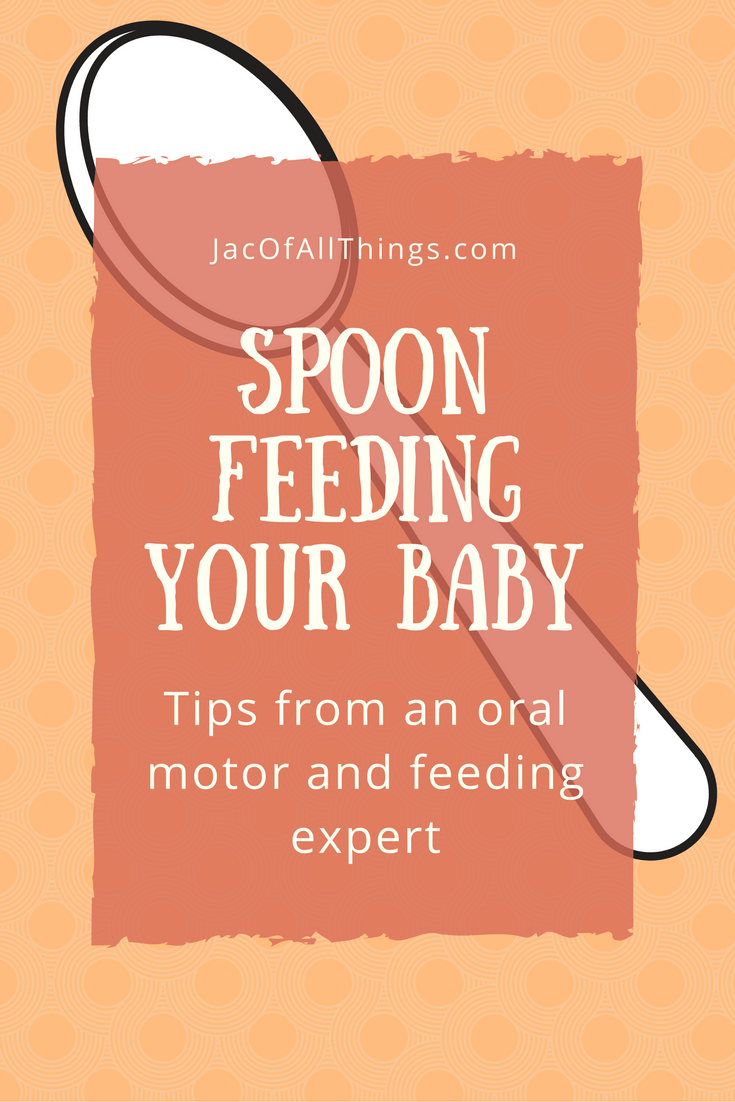“Spoon-Feeding Your Baby – Tips from a Feeding Therapist”, is a guest post by Drake Hastings. Drake is a pediatric Speech-Language Pathologist who specializes in the sensory and oral motor aspects of speech and feeding. Drake provides services to children of all ages at Alphabet Soup in Norwalk, CT.
The purpose of this post is to:
1. Inform caregivers of the oral sensory-motor benefits that occur with proper spoon-feeding
2. Provide strategies that facilitate proper spoon-feeding
Disclosure: We are a participant in the Amazon Services LLC Associates Program, an affiliate advertising program designed to provide a means for us to earn fees by linking to Amazon.com and affiliated sites. I may earn money or products from any of the companies mentioned in this post. Purchasing through an affiliate link comes at no extra cost to you. Note that my recommendations are included because I think they are they are helpful and useful, not because of commissions I make if you decide to buy something.
Taking the perspective of the infant/toddler:
Imagine sitting in a restaurant where you’ve never tried the food. Imagine all of the staff at this restaurant speaks a language you do not completely understand. All of a sudden the waiter sneaks up behind you and shoves a large spoonful of food into your mouth, with a smile. You’ve never seen this food before and you’re unable to ask the waiter what he is serving. Since you don’t speak the language, you are only able to gesture to the waiter to express whether or not you like what you are eating. The waiter doesn’t understand, and proceeds to shove another oversized spoonful of food in your mouth. You decide that you do not like the new food and try to get up and leave the table. The only problem is you’re strapped into the chair, and the waiter is the only person who has the power to free you from your seat. It is now apparent to the waiter that you do not like the food. He frees you from your seat, and you quickly find the nearest exit. Chances are, you’re not going to want to come back to this restaurant…
Mealtime has the potential to be a fun and social experience for any child, when he or she is given the right support. The following will include considerations for spoon-feeding children who have otherwise typically developing sensory and motor systems.
Oral Sensory-Motor Considerations for Spoon-Feeding
Spoon-feeding from an oral sensor-motor perspective can be used to facilitate many muscle movements and motor patterns.
First we want to consider:
1. The shape of the spoon being presented
2. The presentation of the spoon
3. The amount of food
Shape and Size of the Spoon:
Spoons should be flat and narrow enough to easily fit into the child’s mouth. A maroon spoon or any spoon with a similar shape and size is a preferred spoon for the early stages of feeding. This type of spoon presents with a shallow bowl and a narrow overall body.
The amount of food– At the beginning of the meal, dip the spoon into the food to just have enough on it for the baby to taste the food.
Presentation of the Spoon:
More often than not, we see parents shoving the spoon into the baby’s mouth (with good intentions) and dump the food. Dumping the food looks like it sounds. The adult lifts the spoon up and clears the spoon with the upper lip of the infant. This may be an effective way to get food into the child’s mouth, however it does not allow the child to practice using the muscles in their lips, cheeks, and jaw in a more controlled and mature manner.
Keys to presenting food with a spoon:
1. Experience the food – Let the child see and smell the food before you place it in their mouth. Let them touch it gently with their fingers, then move slowly towards their mouth.
2. Presentation – Offer the spoon to the baby straight in and straight out. This will encourage the child to clear the spoon using the muscles in and around their lips.
3. Handling refusal – If they refuse, offer the baby a couple of attempts at just “kissing” the spoon to experience the texture and the taste of the food on their lips, in a playful manner. Do not rush the experience.
Spoon-feeding from a therapeutic perspective
Many aspects of the sensory-motor system are involved in spoon-feeding. The following are just a few considerations and benefits to therapeutic spoon-feeding.
1. When the spoon is presented in a straight in/out motion the baby has to use the muscles in their lips to clear the bolus (food) from the spoon. These are the same muscles that are used to produce the /m/, /p/, and /b/ sounds.
2. Presenting the spoon straight on (with the appropriate sized spoon) will facilitate lip rounding.
3. Presenting the spoon sideways, or at corner of their lips, will facilitate lip closure.
4. Lip rounding is also important for the muscles that make the sounds (i.e. oo, /w/, uu).
5. Lip closure is important for the muscles that make the sounds (/m/, /p/, /b/).
6. Lip closure is also important for saliva management, and for keeping the food in our mouth while we eat.
7. Over time, presenting the spoon in this manner will allow the baby to practice using muscles in their jaw as they open and close their mouth to accept the food in a more controlled manner.
Final Considerations:
At first, spoon-feeding will be an unfamiliar experience for the infant. Remember the example of the waiter above whenever you spoon-feed your child. Ask yourself, “How would this feel if someone was doing this to me?” As a parent or caregiver, you have the ability to create a positive feeding experience by watching and listening to the gestures and sounds of the child. Be aware of the environment and how they are responding to what is happening around them (i.e. noise levels, lighting, temperature).
One of the best things a caregiver can do is remain as calm and neutral as possible, whether the child accepts or rejects the food. Also, offer new foods and “non-preferred” foods as often as possible with an open mindset. Just because the infant refuses the food one day, does not mean they will refuse the food the following week. Stay calm, be consistent, and at the start of each meal tell yourself, “We’re going to have a great meal!”.
Written by Drake Hastings
http://www.alphabetsoupomtherapy.com/
Related Posts
Questions to Ask When Choosing a Daycare
Intentional Parenting: 10 Tips to Parent with Purpose
Receive Weekly Life Hacks
Subscribe to receive exclusive life hacks and practical information sent directly to your inbox! By using this form you agree with this site's privacy policy.






0 Comments
Trackbacks/Pingbacks